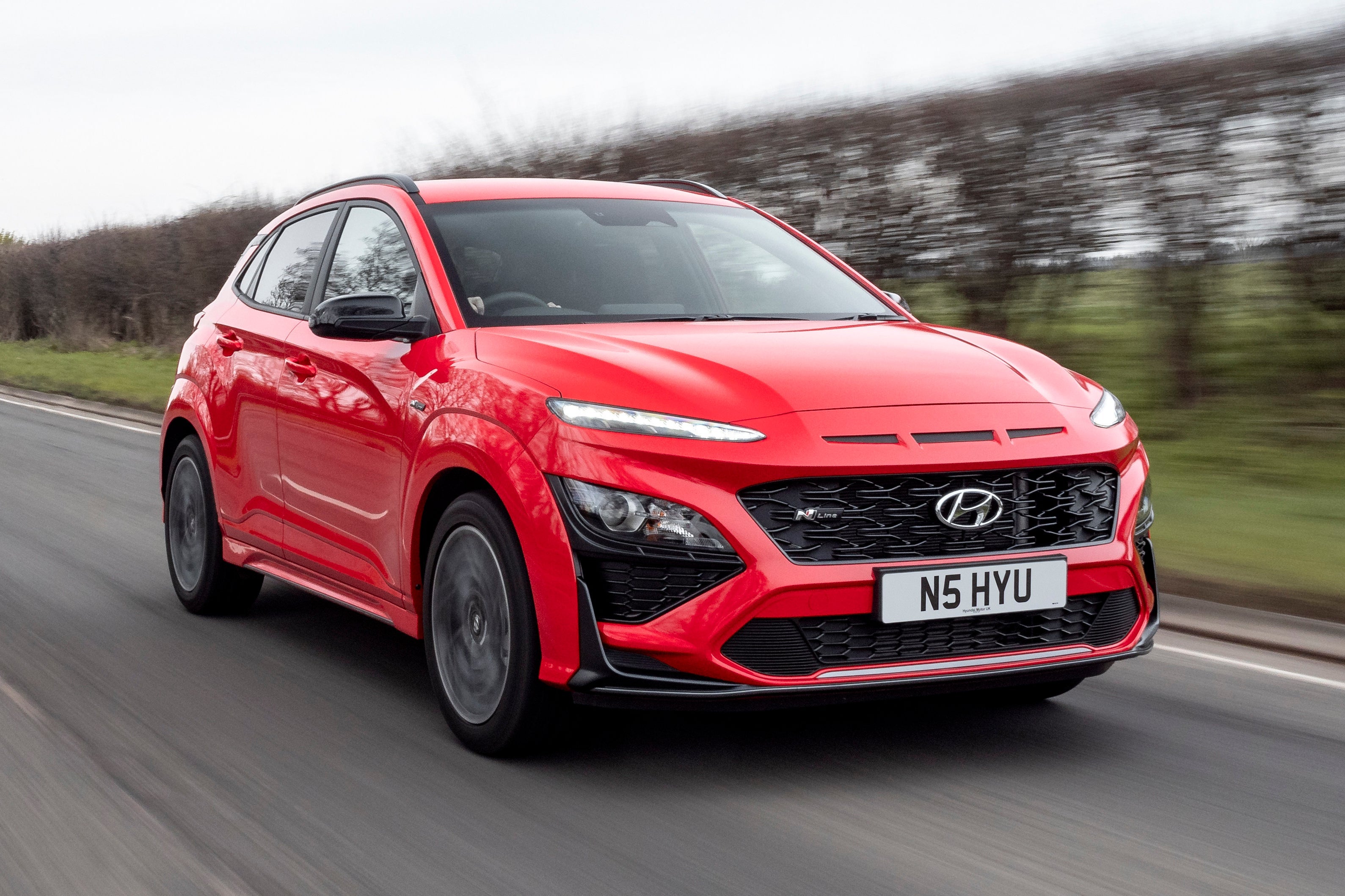Hyundai Kona (2017-2023) Review
Written by Andrew Brady
Quick overview
Pros
- Generously equipment levels
- Great infotainment hardware
- Five-year-warranty
Cons
- Drab interior design
- Firm ride and uninspiring handling on early models
- Hybrid models are expensive
Overall verdict on the Hyundai Kona
"The Hyundai Kona isn't in the same league as the Skoda Kamiq or Ford Puma, but it represents reasonable value for money. The latest revisions have made it a bit more competitive, but it's still not the most practical choice – nor the best drive."
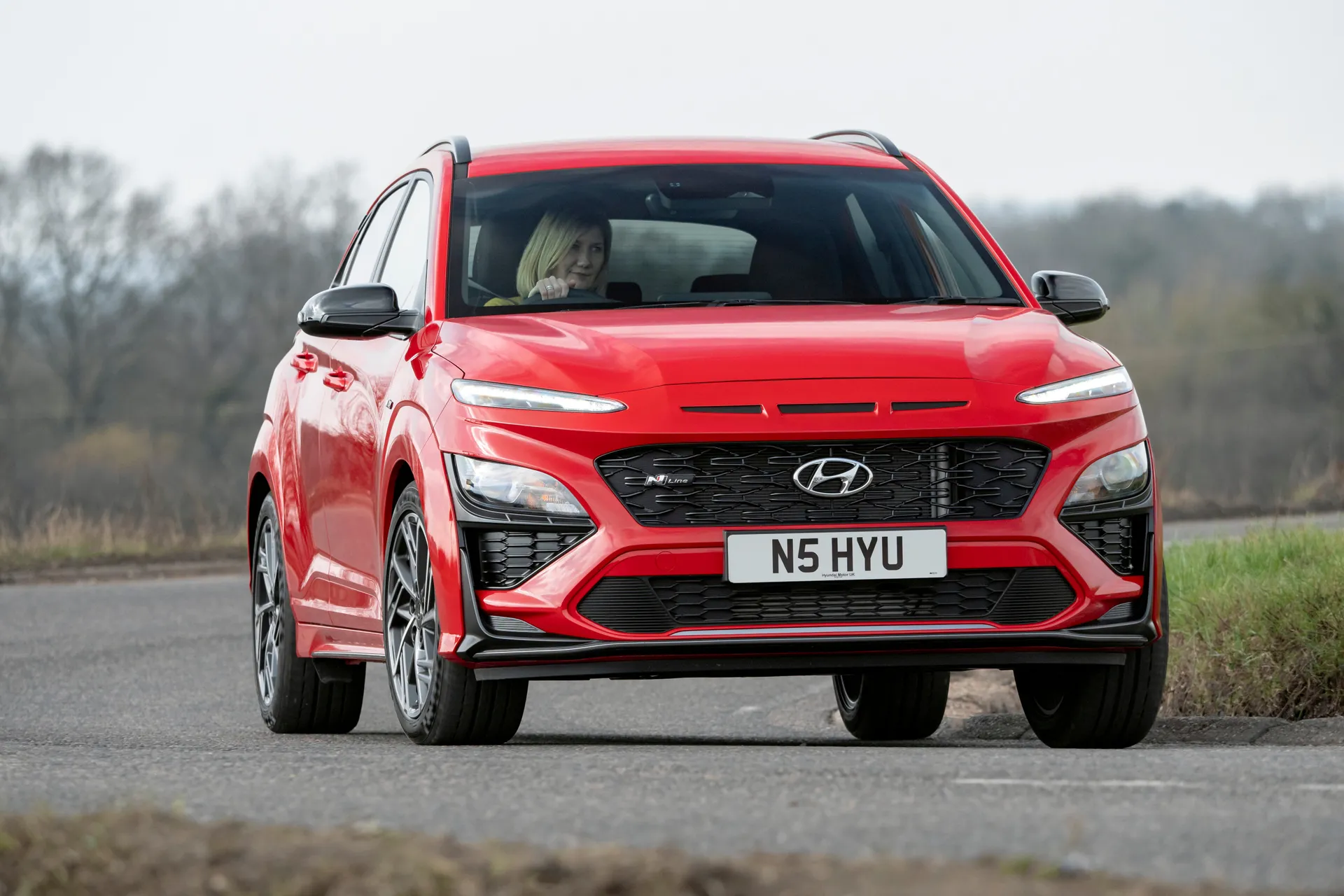
The small SUV market has been given a radical shake-up in recent years. As recently as 2017, when the Hyundai Kona was launched, a new small SUV could get away with being a bit mediocre. Back then, it only had to beat the cheap (and not so cheerful) Vauxhall Crossland X, and the popular (but below-par) Nissan Juke.
But there have been some really good arrivals within the last year or two and our review of the Hyundai Kona will explore how it stacks up against the competition. The Ford Puma and Skoda Kamiq are two of our favourites, while there’s also been a brand new Renault Captur and a (much improved) Nissan Juke.
That’s why the Hyundai Kona’s recently been given quite a substantial facelift. Quite literally – with a heavily redesigned front end to make it stand out from the crowd. We’ll let you decide how successful that’s been.
The engine line-up has been revamped with electrification in mind, as is the current trend. The current range includes a 1.0-litre petrol with mild-hybrid tech; a 1.6 hybrid with a six-speed dual-clutch transmission; and the star of the show: the Kona Electric with its 39kWh and 64kWh battery options. We’ve written about the Kona Electric over here.
If you’re looking on the used market for a Hyundai Kona, you’ll see the same 1.0- and 1.6-litre petrol engines, albeit without hybrid technology. There was a 1.6-litre diesel briefly offered, too, although it sold in tiny numbers so don’t pin your hopes on finding one.
None of the conventional engines are particularly thrilling (go for the Hyundai Kona Electric model if you want some serious overtaking punch), while the Kona has never handled as well as the SEAT Arona. The suspension was revised in 2021, meaning it now handles bumpy road surfaces better than it did before.
Of course, being a Hyundai, the Kona represents decent value for money. A new one will set you back upwards of £21,000, although top-spec Hybrid models are nudging £30,000 once you’ve selected a few extras. On the used market, a budget of around £10,000 will pick up an early example.
Looking for a used car for sale? We've got 100s of Hyundai Approved Used Cars for Sale for you to choose from, including a wide range of Hyundai Kona cars for sale. If you're looking for the newer version, you need our Hyundai Kona review, while you might also be interested in our Hyundai Kona Electric review.
Is the Hyundai Kona right for you?
One of the big selling points of the Hyundai Kona is its distinctive design. Some buyers will love it, for others it will be a turn-off, but either way the colourful exterior, high driving position and easy driving manners are all positives. It'll suit buyers who want something with a bit more personality than a small family hatchback.
It's not especially practical, with other cars in this price range providing more boot and passenger space, so if you regularly carry adults, there are better options out there. The hybrid is cheap to run but expensive to buy.
What’s the best Hyundai Kona model/engine to choose?
If you're looking for a pre-facelift example, the front-wheel drive 1.0-litre petrol turbo will be the best option for the vast majority of buyers. It’s not the smoothest, but flexible enough to keep up with motorway traffic, with a tall sixth gear that helps refinement when cruising. It’ll be kind on your wallet too, with an official economy of 45.6mpg and just 121g/km of CO2.
Avoid the entry-level Hyundai Kona S trim at all costs. It’s too basic to recommend, even as a used bargain, the SE model offers the best balance of equipment and price, and its smaller alloys help to mitigate the Kona’s other main issue, a jiggly and firm ride that never truly settles. On larger wheel's you'll be gritting your teeth over bumps.
What other cars are similar to the Hyundai Kona?
The Hyundai Kona is part of the fastest expanding group of cars on the market: small SUVs. A market that exploded in popularity with the arrival of the first versions of Nissan Juke, Renault Captur and Peugeot 2008. Now all three cars have been replaced with a brand new generation that are better to drive, more refined and offer an increasingly level of technology and luxury kit on board, with prices rising to match their new status.
Still, if you want a high driving position on a tighter budget, you could buy a jacked-up version of a small hatch instead. Cars like the Ford Fiesta and Hyundai's own i20 Active give you a mini-SUV flavour for less cash. For a more grown-up driving experience, the Ford Puma is great fun in corners, while the Volkswagen T-Roc is composed and refined. Both are available with punchy 150PS engines that deliver surprisingly brisk pace.
Company car drivers interested in the Kona hybrid should check out Toyota's C-HR, which is even lighter on fuel, managing the transition between petrol and electricity a little more seamlessly than the Hyundai does.
Comfort and design: Hyundai Kona interior
"We wish Hyundai had been as adventurous with the Kona's cabin as it was with the exterior, since this is an interior that scores highly for its simple functionality, but disappoints with a lack of visual flair and excitement."
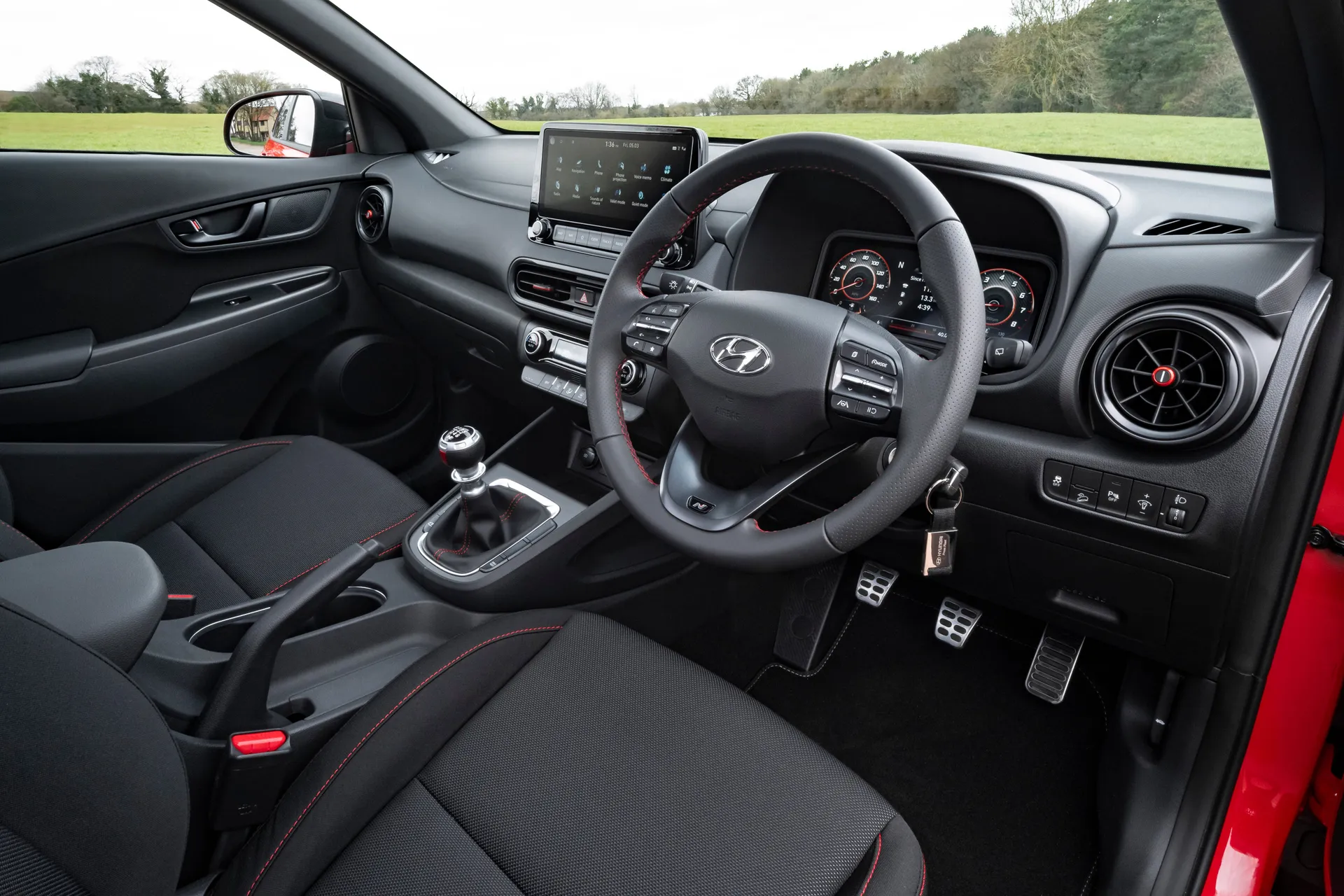
The Hyundai Kona's controls are very logically laid out, and the 7-inch screen that’s standard on most cars is placed right in the driver’s eye-line, and within easy reach of the steering wheel, but it’s a rather drab place to spend time.
This stuff really matters in a class that contains chic competitors with elegant and upmarket interiors that reflect a bit more individuality, including the ultra-modern Peugeot 2008 or the impeccably finished Audi Q2. There's limited scope for confusion at least, and changing the temperature or radio station is a total doddle.
Still, plenty of small SUV buyers will be more concerned with comfort than style, and the Hyundai Kona scores highly in that regard. The raised driving position has been perfectly judged, but if you want to tailor it to fit your own shape and size, there's a wide range of manual adjustment to the location of the seat and steering wheel.
Another pleasant surprise is the inclusion of electric lumbar support on Premium models. The seats are padded and comfortable anyway, but the ability to alleviate backache after hours at the wheel is a real boon.
Visibility is great in every direction except over-the-shoulder, where the chunky styling means you get a small rear window and big blindspots, but reversing around obstacles is made easier by the rear parking sensors.
Quality and finish
The Hyundai Kona has the exact same traits as many of Hyundai's other models when it comes to its fit and finish. It's very sturdily built, and feels robust enough to cope with years of abuse, but the materials used are also tough.
The dash and most of the cabin is covered in a hodgepodge of different hard, scratchy plastics, all of which are varying shades of dull grey. Odd areas get a soft-touch finish, but not enough, and it could really do with a splash of colour to brighten the mood. You can add optional contrasting trim, but only on the pricier models.
On the plus side, all but the entry-level models get soft leather upholstery on the two more important points of contact, the steering wheel and gearstick, while the top spec versions have faux-leather trim throughout.
Flick an indicator stalk, twirl the climate controls or pump up the volume using the buttons on the wheel, and each time you'll be impressed with their tactile precision, but the flimsy gearbox and armrest lids disappoint.
While it's true that many rivals feature some hard finishes and ordinary designs, cars such as the Skoda Kamiq lead the way in this class, proving that with the right approach you can make a small SUV feel plush.
Infotainment: Touchscreen, USB, nav and stereo in the Hyundai Kona
While every version of the Kona comes packing an infotainment screen, on the most basic models it's a tiny 5-inch monochrome display that's not particularly attractive or slick.
Luckily, you only need to up to the SE to get your hands on a bright 7-inch colour touchscreen but both have Bluetooth, DAB and six speakers. However, only the latter features full smartphone compatibility for both Apple and Android phones, with the right software to allow you to use your favourite streaming and navigation apps in a safe way while driving.
The infotainment system itself is reasonably intuitive, with nice physical shortcut buttons flanking the display, which are easy to hit on the move, and scrolling through radio stations or pairing a new device is very simple.
Upgrading to the Hyundai Kona Premium SE or higher brings you a larger 8-inch touchscreen with a built-in navigation system and punchier audio system. It's graphically sharper and quicker to respond than the standard unit, and you get gadgets like a wireless phone charger and a head-up display thrown in that make the Kona feel hi-tech.
That's not the last word in technology though. In the hybrid models, this upgraded system gets a widescreen 10.25-inch monitor that looks super slick and is one of the most impressive we have used on a car this size.
Space and practicality: Hyundai Kona boot space
The idea behind small SUVs like the Hyundai Kona is that they are more practical than the small hatch they are often based on, yet the Hyundai struggles to match its roomiest competitors for either passenger or boot space.
Up front this still feels like a small car, rather than a SUV. The cabin is narrow, and while you can stretch out without invading anyone's personal space, it feels a little more intimate than you might expect. Keeping the car tidy is no hassle though, with a decent glovebox, big door pockets, and a wide phone tray close at hand.
The further back in the Hyundai you sit, the less generous the dimensions become so taller people in the rear seats may find their heads brushing the roof lining. If they're unlucky enough to be behind a tall driver, their kneecaps will be wedged against the front seat backs too; not exactly ideal on a long drive somewhere.
Hyundai at least provides slim rear door pockets and a narrow armrest in each rear door, but on a long journey you'll hear more complaints from your passengers than you would in rivals such as the Volkswagen T-Roc. Unlike the Renault Captur and Citroen C3 Aircross, you can't slide the back seats forward and back, which means less flexibility to prioritise passenger space or boot volume, a feature that family buyers appreciate.
Speaking of volume, at 334 litres, the boot space is below average for the class. Still, the opening is wide enough to make it easy to load bulky items, and when you fold down the split-folding seats they leave a flat loading bay. In this mode, the Kona can carry up to 1116 litres of stuff, but again this is less than you can fit into its rivals.
Entry-level Kona S models get fractionally more storage space under the boot floor (where the spare wheel goes on other trims) but even without it, the boot is dwarfed by other small SUVs. It's big enough to take carry-on suitcases and shopping bags, but buyers who regularly need to carry larger items will struggle to fit them all.
If you've got a tight driveway, note that the Hyundai Kona is 4165mm long, 1800mm wide and 1565mm high.
Handling and ride quality: What is the Hyundai Kona like to drive?
"It's a simple fact that taller cars tend to handle less fluently than lower ones. The physics involved mean a higher car usually rolls more in corners, requiring stiffer suspension to keep its body movements in check."
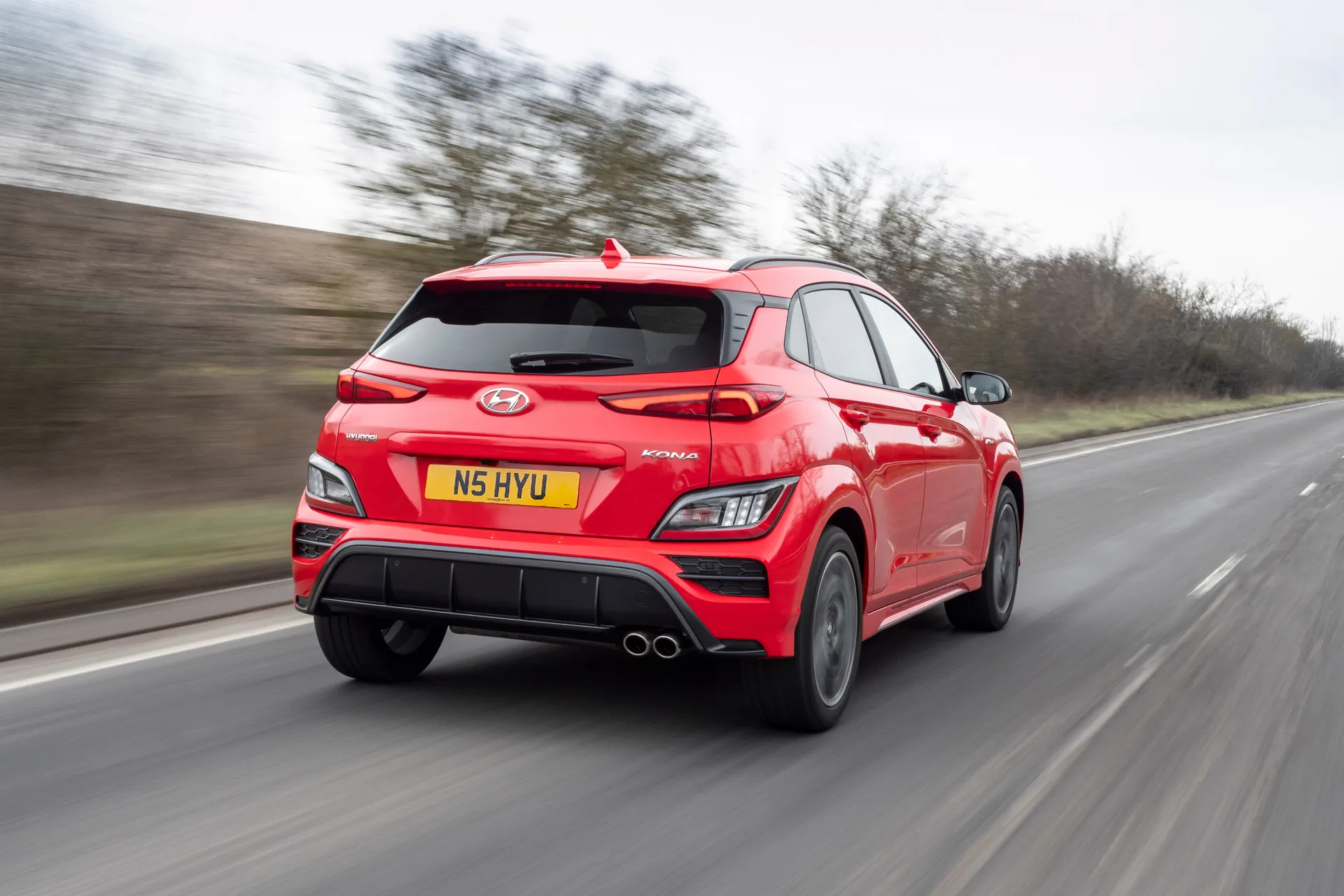
These drawbacks afflict all raised-up SUVs, but in light cars like the Kona it's harder to find the right balance between comfort and composure, since there's less weight to help smooth out the ride.
Hyundai has chosen a stiff setup that means you get sharper handling and less body lean than rivals such as the Citroen C3 Aircross or Renault Captur. It stays upright as you turn into corners, generates surprising grip and changes direction deftly, although the lardy hybrid leans over a little more than the featherweight petrol.
Unfortunately that does mean it's quite sensitive to uneven surfaces. Run over a big pothole and you'll feel a nasty jolt that'll make you wince, and the wheels patter over rough roads, picking up every scar and crease. For this reason we'd avoid models fitted with 18-inch alloys, you'll be a lot comfier in a Kona on smaller rims.
On smoother Tarmac, the ride settles down nicely, but its not quite as supple as a Ford Puma or Volkswagen T-Roc. The quicker 1.6-litre and hybrid model get a more sophisticated rear suspension setup than the standard car, but that's more to accommodate the four-wheel drive system and battery pack than to improve the handling.
Around town, buyers will appreciate the light steering. It barely requires any effort to twirl the wheel back and forth when you're parking or making a three-point turn, but doesn't gain meaningful weight in faster driving. It therefore lacks the precision and accuracy present in some rivals, including SEAT's Arona, which is more fun.
What engines and gearboxes are available in the Hyundai Kona?
At launch the Kona was available with a 1.6-litre CRDi diesel, and a pair of more popular petrol turbos. The first is a 1.0-litre with three-cylinders and 120PS that'll be more than adequate for most buyers, but those seeking a larger dollop of performance could pick a 1.6-litre with 177PS, four-wheel drive, and an automatic gearbox.
In 2019, the diesel was replaced with a petrol-electric hybrid in a similar mould to the Toyota CH-R. This also uses a 1.6-litre engine, paired with a small battery and a 43PS electric motor. It doesn't need plugging in, but helps improve economy and lower emissions significantly, and makes the Kona feel responsive in the city.
A 1.0-litre unit might not sound like much in a chunky SUV, but it's easily our favourite in the range. For starters, it's the most affordable and cheapest to insure. It's no slouch either, feeling eager and happy to rev. It does need some encouragement to overtake, but the six-speed manual is no chore, with a nice light shift.
Still, similarly sized units in the SEAT Arona and Ford Puma pack more of a punch. Both these rivals are over two seconds quicker in a benchmark sprint from 0-62mph, and you will notice the difference in daily driving.
We would avoid the temptation to go for the 1.6-litre model. It's only available with a dual-clutch transmission that can swap through its seven speeds with impressive smoothness, but it's very expensive to buy and run. It's undoubtedly quicker, but the penalties you pay for the boost in speed are just too high. We'd much prefer a middle option with around 150PS and front-wheel drive, like you can get in the Volkswagen T-Roc or Mazda CX-30.
Refinement and noise levels
The Kona provides a decent level of accident protection. All models come with six airbags to deploy if the worst happens. A driver attention alert will pop-up to remind you to take a break if the car thinks you are driving more erratically than usual, and there's a lane-keep assistant that can gently steer you back straight.
When it was tested by Euro NCAP in 2017 it managed a maximum five-star rating overall, but when you look closer at the individual grades, you discover that it scored just 87% for adult safety; most rivals get over 90%.
It returned decidedly average results in the pedestrian and safety assist categories too. That's because on all but the most expensive trim levels, automatic emergency braking (AEB) is optional. This critical kit is there to help drivers avoid accidents in the first place. It scans the road ahead with a camera, and if the car detects a potential collision with a cyclist, pedestrian or car in your path, it'll warn the driver and start braking if needed.
Many small SUVs now come with AEB as standard. While you can add it to the Hyundai on every trim level (as part of the brand's bigger SmartSense active safety pack) it's such a useful feature it should be included. On the plus side, it's an inexpensive option, and we'd suggest that for peace of mind, it's a box worth ticking.
Choose this bundle on the hybrid, and you'll get radar-guided cruise control too, while Premium trim includes a set of blind spot monitors, and a system that'll warn you about passing traffic when backing out of a space. Thankfully, rear sensors and a reversing camera are standard on most trims; taking the stress out of parking.
MPG and fuel costs: What does a Hyundai Kona cost to run?
"Although the Kona has a similar footprint and the same engine to the i20 hatch, its raised ride height and chunky styling means it'll be slightly less economical in day-to-day driving."
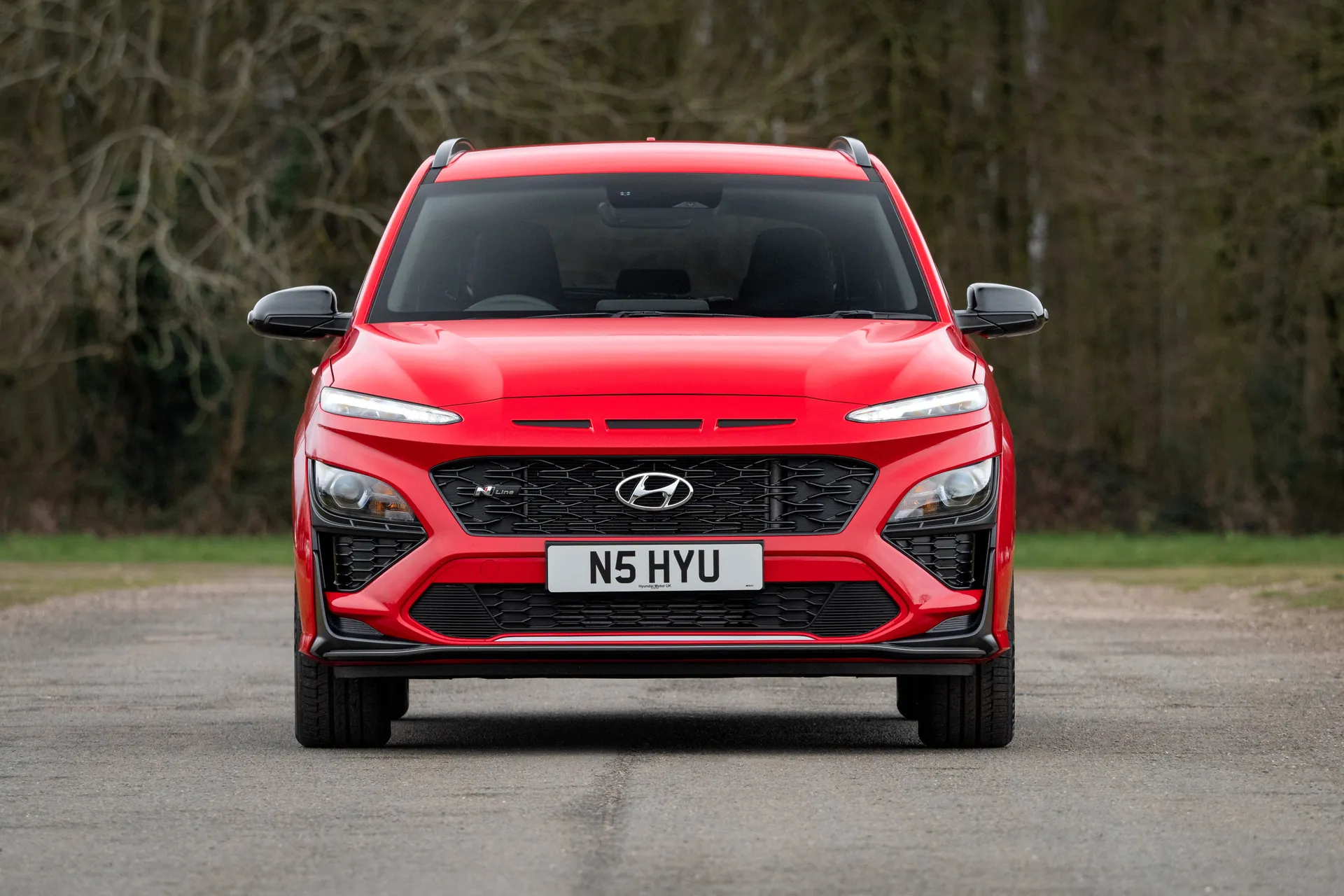
The official WLTP figures for the popular 1.0-litre three-cylinder turbo is 45.6mpg in 'S' trim, falling further as you add kit and larger wheels. However, our Real MPG owners averaged just over 40mpg with this engine, which might give you a taste of what is realistic to expect in normal traffic conditions or with several passengers and their luggage on board.
The newer hybrid version really is the pick of the bunch if cutting your fuel bills is a top priority though. Its official figures suggest it will return well over 55mpg, and our own experience with the car backs that up.
Unlike some rivals, it doesn't need plugging in. The small on-board battery regenerates itself as you drive. One thing to note: the petrol tank in the hybrid shrinks by a quarter, so there's no difference in cruising range.
How reliable is a Hyundai Kona?
Hyundai is one of the most reliable new car brands, achieving an reliability score of 9.38 out of 10 in the latest HonestJohn.co.uk Satisfaction Index.
A five-year, unlimited mileage warranty ought to put your mind at rest, while servicing shouldn't break the bank, either.
Insurance groups and costs
The good news for teenagers that are hoping to borrow the car from mum and dad, is that the Kona is in such a low insurance group you might be able to sneak onto the comprehensive cover as a named driver.
Pick the 1.0-litre GD-i engine, and in either S or SE trim it sits in group 9 - the same as some city cars. Only the less powerful Renault Captur is lower, with the average for basic versions of most rivals group 13 or so.
That's the same bracket as the considerably more powerful and expensive hybrid model, which drops as low as group 11 if you go for the priciest Premium SE version, thanks to its added active safety equipment.
VED car tax: What is the annual road tax on a Hyundai Kona?
The most affordable version of the Kona to tax is (unsurprisingly) the hybrid model. It won't save you a big heap of cash compared with the standard petrol though; just an extra £10 off the £150 standard rate charge. That's because it qualifies for the alternative fuels discount, although £100 over the course of a decade is not exactly going to thrill your accountant. Things do start to add up once you factor in the first-year rate, though.
This is a CO2 based charge levied against all brand new cars. In the Kona hybrid, it'll cost you £165. Buy the popular 1.0-litre petrol you'll need to pay another fifty quid, but pick the top spec 1.6-litre and it leaps to £870.
It's a different story with company car tax. The hybrid sits in the lowest BIK bracket at 25% in SE trim, but it'll actually cost you a few extra pounds a month because of its higher purchase price than the 1.0 GD-i at 31%.
How much should you be paying for a used Hyundai Kona?
"New prices for the Kona start from £18,000 and climb all the way up to £28,000 for the all-singing four-wheel drive model in the flashiest Premium GT specification. To secure a used model, you'll need at least £10,000."
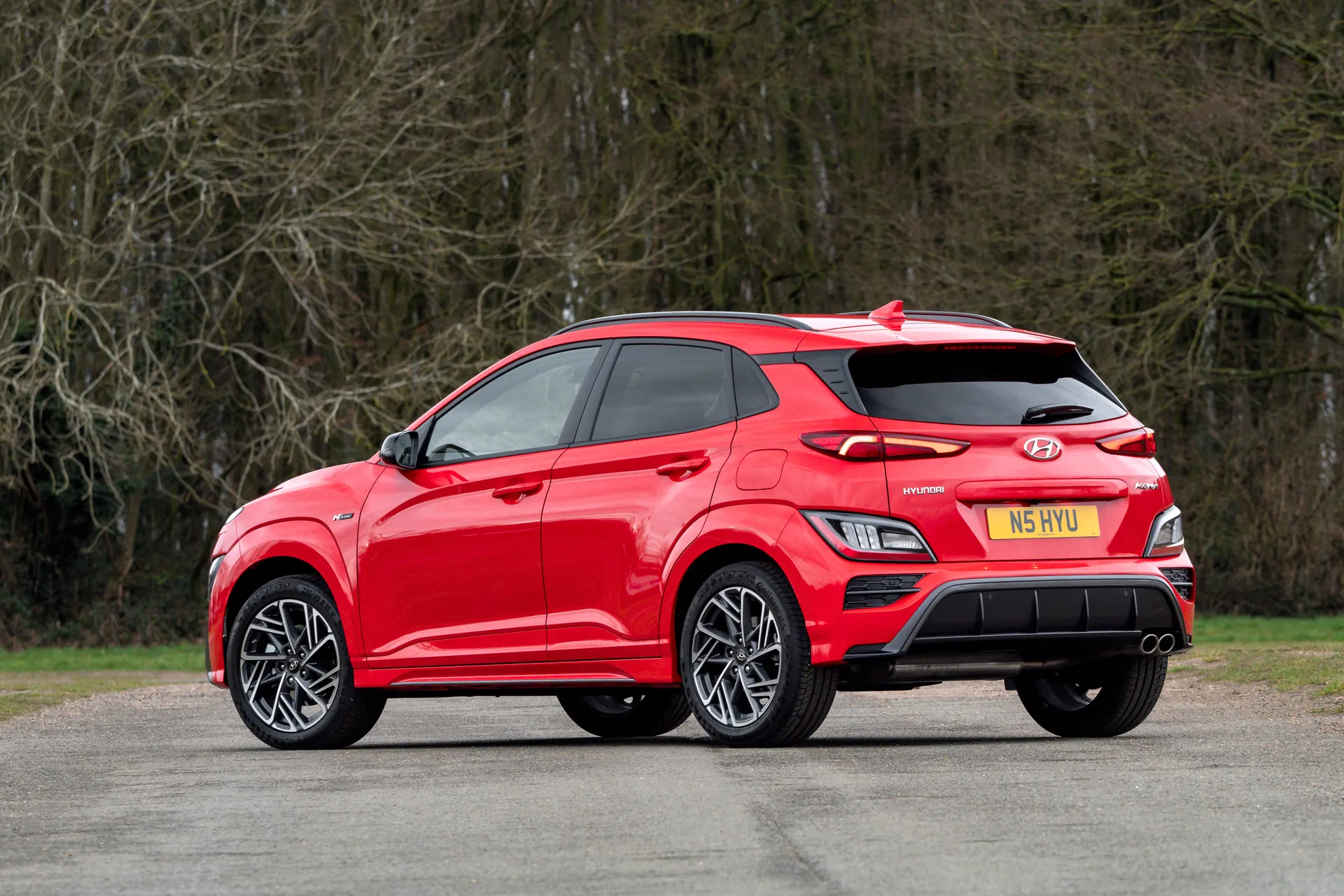
There aren't many used Hyundai Konas available for £10,000. If you want a quick buy, set your sights on cars that sit between the £12,000 and £13,000 mark, and you'll find an abundance of 1.0-litre petrols, in a choice of trims, all with lowish miles.
Buying a pre-registered car from 2019 could save you several thousands, and we found a number of cars in the attractive looking Play trim with less than 500 miles on the clock, for less than £15,000; a proper bargain.
To get behind the wheel of the four-wheel-drive model, they change hands for around £18,000 for a car with a fully stamped service book and less than 20,000 miles showing. That's a good saving on the new list price.
Forget about picking up a diesel. Finding one is next to impossible, and it's priced to match its elusive status.
Trim levels and standard equipment
Hyundai is known for being generous with its standard equipment. The brand usually packs in a wide set of features, especially on its priciest models, and you can often find a nice middle ground between cost and kit.
This holds true in the Kona. Earlier models were available in six trim levels, but we would avoid the bookends (S and Premium GT) and concentrate on the middle four instead. Entry-level cars get basics such as alloy wheels, cruise control, and Bluetooth, but you'll want to upgrade to SE trim for its seven-inch touchscreen and rear parking sensors.
Hyundai Kona Play models have 18-inch wheels and Metallic paint included, but it's only once you step up to the Premium specification that you'll get goodies like climate control, keyless entry, and an auto-dimming rearview mirror. These versions also benefit from an eight-inch infotainment screen, with built in navigation, double the number of speakers (including a subwoofer) and a punchier audio system, plus fancy gadgets like a wireless charger.
At the top of the tree is the Hyundai Kona Premium GT and it comes fully loaded, with LED headlights, leather seats that can be heated or cooled to your liking, and even a head-up display, but it was prohibitively expensive when new and isn't much cheaper on the used market.
As of 2021, the range starts with the Hyundai Kona SE Connect. Standard kit includes 17-inch alloy wheels, body-coloured door mirrors, roof rails and a rear spoiler. Inside, there's manual air conditioning, a 10.25-inch digital instrument cluster and an eight-inch media display with Apple CarPlay and Android Auto. Passenger-seat height adjustment is a desirable feature, added when the Kona was updated in 2021.
The sporty new Kona N Line trim adds quite a considerable amount of equipment for the money. As well as unique front and rear styling and 18-inch diamond-cut alloy wheels, the entire front bumper and the wheel-arch claddings are in body colour. At the rear, there are LED lights. For the cabin, the new Kona N Line is equipped with unique detailing including distinctive red stitching, metal pedals, and N logos on the gear shift and on the seats. There's also climate control, automatic dimming rear-view mirror, automatic windscreen wipers, USB ports for rear-seat occupants, rear parking sensors, and interior ambient lighting. The driver can also fold the door mirrors at the touch of a button.
The centre console display increases from eight-inch to 10.25-inch and incorporates navigation. There's also a premium sound system as standard.
The Hyundai Kona Premium adds anthracite body garnish to the exterior and distinctive 18-inch alloy wheels. Inside there are heated front seats, electric parking brake and front parking sensors, and the active safety features are augmented with Intelligent Speed Limit Warning (ISLW).
In addition to all of the features available with Premium spec, the top-spec Hyundai Kona Ultimate adds LED headlights, electric front seat adjustment, and an electric tilt and slide sunroof. Added to the active safety systems are Blind Spot Collision Warning (BCW), Rear Cross Traffic Collision Warning (RCCW), and the new Safe Exit Warning (SEW) system, which prevents passengers from exiting the vehicle if it is not yet safe to do so.
Ask the heycar experts: common questions
Is the Hyundai Kona a hybrid?
Does the Hyundai Kona come with all-wheel drive?
Is the Hyundai Kona an SUV?
What about the Hyundai Kona Electric?
Get our latest advice, news and offers
Keep me updated by email with the latest advice, news and offers from heycar.
By submitting you agree to our privacy policy
